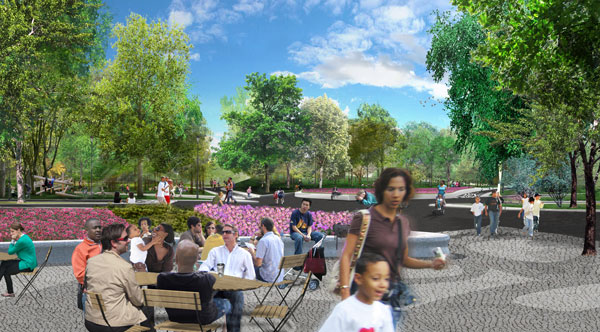 [/media-credit]
[/media-credit]
Governors Island’s parks and public space master plan, which will be put into action starting this spring. By 2013, Liggett Terrace, which refers to the six-acre, 2,600 space parking lot and lawn adjacent to Liggett Hall, will be fully ready for use by the public, according to Leslie Koch, president of the Trust for Governors Island. The terrace sits next to the landmarked, brick-and-limestone Liggett Hall, which, erected in 1929, was the first permanent building on the island’s landfill and will be preserved by the Trust.
“There’s no need for the parking lot,” said Koch, particularly since non-personnel cars aren’t permitted onto the island. “We thought it was more important to create a beautiful public space.”
C.B. 1’s landmarks committee approved the Trust’s design of the island’s historic district with reservations it will outline in a forthcoming resolution. Committee chair Bruce Ehrmann, for one, would greatly prefer to see the existing Liggett Terrace retained as is.
The neoclassical qualities of Liggett Hall reinforce the notion that the six acres should adhere to the same architectural style, according to Ehrmann. “The space in front of the building looks rectilinear, and the building’s design is rectilinear. This is a typical formal pattern that Beaux-Art architects have used time and again,” he said.
“Now they’re putting in this trendy, biomorphic planting space that absolutely obscures all of that,” Ehrmann continued. “There’s plenty of space to do that in the acres [of park space] that aren’t landmark-designated.”
“The issue is, we’re a landmarks committee – we’re responsible for protecting landmarks,” chimed in Jeff Ehrlich. “We’re concerned that we lose something as this gets covered up.”
To Ehrmann’s point, scant evidence has been found that architect firm Mckim, Mead and White had neoclassical intentions in mind when designing the building, according to Koch, who personally visited the NY Historical Society to examine the original drawings of Liggett Hall. “There was nothing to suggest any sort of design for a Beaux-Art plaza,” she said. “Instead what we felt was important was to respect that beautiful building, which is of course a landmark, and encourage the new park and public space uses [of the island].”
The name “Liggett Terrace” was only conceived by the Trust a couple of years ago, Koch noted. “It’s not historic,” she said.
Other committee members were enthralled by Koch’s presentation. “I think the design is just terrific,” said committee member Susan Cole of the overall plan. “I like the open space, the thoughtfulness of the green, and how they’re trying to integrate the Brooklyn ferry stop to make it a more pleasant arrival.”
“It’s clearly a labor of love – you’ve put so much thought and detail into it,” echoed committee member Vera Sung.
Architect Corie Sharples also applauded the design. “It seems like your research shows this wasn’t a formally planned, formally designed space, so I feel like you’re not detracting from the historic [element],” she said.
On a separate note, new promising initiatives mentioned by Mayor Michael Bloomberg during his Jan. 12 State of the City address may be brought to Governors Island in the near future. “Out in the harbor, we’ll continue to be transforming the island… with 30 new acres of parkland that will make Governors Island one of the great waterfront destinations in the world,” said Bloomberg during his speech.
In particular, Bloomberg discussed “Space Works,” a city-launched organization that would secure long-term affordable rehearsal and studio space for artists at locations around the city that would possibly include Governors Island.
Koch said she would embrace the program. “We’ve become an extra destination for arts and culture – one of our tenants, the Lower Manhattan Cultural Council, runs year-round – and we’d love to see even more artist activity on the island, both as [part of] our public access programming calendar and our year-round tenancy,” said Koch. “We’re excited about New York continuing to be a capital for the creation of art, and for Governors Island to play a leadership role in that.”
Bloomberg also talked about a new joint initiative between the city and AT&T that would launch WiFi service in dozens of city parks. Koch said of the initiative, “It’s not an active project at this time, but it’s something we would welcome at some point in the future.”

















